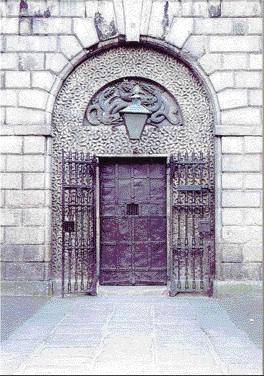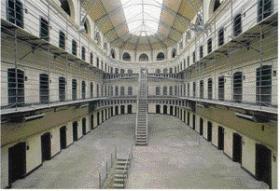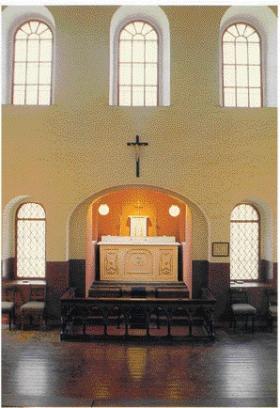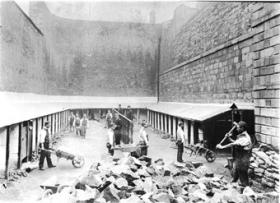Museum Eye
Published in 18th-19th Century Social Perspectives, 18th–19th - Century History, 20th Century Social Perspectives, 20th-century / Contemporary History, General, Irish Republican Brotherhood / Fenians, Issue 6 (Nov/Dec 2008), Reviews, Revolutionary Period 1912-23, Volume 16
The front door of Kilmainham Gaol—first opened (closed?) to prisoners in 1796.
Kilmainham Gaol
Inchicore Road, Kilmainham, Dublin 8
+353 (0)1 4535984
/4532037
(fax), kilmainhamgaol@opw.ie
April–Sept.: daily 9.30am–6pm (last admission one hour before closing)
Oct.–March: Mon.–Sat. 9.30am–5.30pm; Sun. 10am–6pm
Adult €5.30; senior/group €3.70; child/student €2.10; family €11.50
by Tony Canavan
For many years Kilmainham Gaol was a shrine to Ireland’s struggle for freedom in which many Irish rebels were imprisoned and executed, but it is now also a major tourist attraction, visited by people from all over the world and boasting an award-winning museum alongside the actual historic building.
Your visit to the old prison, first opened in 1796, begins with the museum, which is divided into three sections. The first gives a general history of the place, putting it in the context of eighteenth-century prison reform and later ideas on the rehabilitation of offenders. There are imaginative recreations of prison cells, a rolling montage of prisoners’ mug-shots (first used in the 1860s), information on conditions inside the prison and examples of the different forms of hard labour that convicts were forced to do, such as walking the treadmill, picking oakum and breaking rocks.
Attitudes to crime in the nineteenth century, the kinds of treatment meted out to prisoners and just who was sent to gaol can all be very unsettling. There is a whiff of hypocrisy in the Victorian idea that fresh air, sunlight and hard labour would reform someone driven to crime because of extreme poverty or destitution. That even women and children were subjected to various forms of hard labour reveals how charitable notions of reform and redemption masked cruelty and indifference. The youngest person sent to Kilmainham was a five-year-old boy, while a girl as young as eight also served time there for stealing a lady’s cloak.

In the 1860s the old east wing was demolished and replaced by this new one based on the panoptic (all-seeing) principle.
Upstairs there is a section on political history that charts the struggle against British rule from the United Irishmen to the War of Independence. There is an informative display on the Fenians, as the IRB was popularly known, featuring artefacts associated with them, photographs, posters and so on. Other aspects of the campaign for independence are featured too, such as the Invincibles (notorious for the Phoenix Park murders), the role of women, and constitutional politics in the form of Charles Stewart Parnell, reminding us that it was not just armed rebels who were imprisoned here. Most of this area, however, is devoted to the period from 1916 to 1923, with a large concentration on the Easter Rising, for understandable reasons. Most poignant here is the corridor of ‘last words’, devoted to the final letters written by the executed leaders of the 1916 Rising and other memorabilia associated with them.
Upstairs again is an exhibition on the restoration of the gaol, mainly by volunteers, and its development as a museum. The sound of hammering and drilling is testimony to the fact that restoration work on the fabric of the building is an ongoing process.
Access to the prison itself is by guided tour. These are frequent and well attended. I was among a group of about twenty of different nationalities: Polish, German, Dutch, Spanish, Scottish and English, along with some other Irish people. The tour lasts about 50 minutes and is an efficient and brisk walk through the building and its history. Our guide managed to balance the development of the building and the Irish penal system with the story of the prisoners associated with the rebellions and political upheavals of the nineteenth and twentieth centuries. I was struck by how the history of Kilmainham was a social and political history of Ireland. Alongside the various rebellions, we were told about the ‘ordinary’ people convicted for a range of crimes from petty theft to murder, the changing attitudes to how a prison should function, and the impact on Kilmainham of major non-political events like the Great Famine.

The chapel where Joseph Plunkett and Grace Gifford were married prior to the former’s execution in 1916.
There are a number of impressive stops on the tour, beginning with the hang house, constructed for the hanging of condemned prisoners; it is a chilling sight, with a hook embedded in the ceiling above the trapdoor through which the hanged person dropped. Our guide informed us that 144 people were hanged in Kilmainham, most in public at the front gate until the hang house was opened in the 1890s. Only four people were hanged there, however, the last being Joseph Heffernan in 1910.
The tour concentrates on the political history of the gaol, with talks in the ‘1916 corridor’ where many of the Rising’s leaders were held in the days before their execution, a cell in which Parnell was kept during his time here, and then the main wing of the prison, where many of those involved in the Civil War, such as Eamonn de Valera, were imprisoned: some of them were also taken out from here to be executed. The tour ends outside in the stonebreakers’ yard where Patrick Pearse, Thomas Clarke and the other leaders were shot by British firing squad in May 1916.
On reflection, I thought that more might have been said about other patriots held in Kilmainham over the decades, such as Robert Emmet, prominent Fenians such as John O’Leary or O’Donovan Rossa, land agitators like Michael Davitt, and so on. A decision has been made to keep the tour to about 50 minutes, which limits how much of the story can be told, and I suppose this has to be so given the numbers visiting—our party was always only a few steps behind the previous tour and a few steps ahead of the following one. This is not to say that the tour was hurried or superficial. It tackled the politics and the events head on and in a way that left a mark on all of us. Four young English people began the tour in high spirits, openly mocking the conditions in the gaol and the prisoners, but were more subdued after our lecture in the chapel and the story of the marriage of Joseph Plunkett to Grace Gifford hours before his execution. They were reduced to a remorseful silence after we were told how James Connolly was carried to the yard in a stretcher and tied to a chair to be shot. Sometimes the bare facts speak more eloquently than any attempt at rhetoric.

The stonebreakers’ yard, where the 1916 leaders were executed.
(All images: OPW)
When I was growing up, Kilmainham was a must-see place for any Irish visitor to Dublin, and it remains that today even though it is now a major attraction for overseas visitors too. It is a place redolent of Irish history like no other. The building is impressive in itself as an example not just of penal architecture but also of the history of crime and punishment in Ireland. Of course, the political history is what gives it a special place in the Irish psyche, evoking as it does the major events of the last two centuries of Irish history. The unpaid volunteers and, since 1986, the OPW have done a good job in restoring the goal and making it accessible to the public. The museum and the guided tours take in the various aspects of the building’s history, giving a pretty comprehensive picture not just of Kilmainham the gaol but also of Kilmainham as a prism through which to view Ireland’s history. If you have not been there yet I recommend that you go.
















